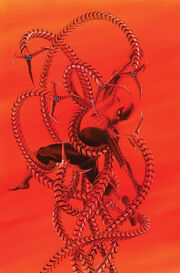History
Origin
Dr. Otto Octavius constructed these to help manipulate radioactive substances from a safe distance, Otto constructed a chest harness controlling four mechanical, tentacle-like arms - earning him the nickname Doctor Octopus.
Capacity
"Doctor Octopus"
Tentacles: Doctor Octopus' superhuman abilities derive from the four mentally-controlled, electronically-powered, telescoping, prehensile titanium-steel tentacles attached to a stainless steel harness encircling his body from lower chest to waist. Each tentacle, approximately five inches in diameter, terminates in three single-jointed pincers. The pincers are able to rotate in relation to the arm for 360 degrees, in a screwdriver-like twisting motion. Each tentacle segment contains four high-efficiency electric motors equipped with a clutched, helical-gear train, independently mounted on frictionless gimbals and housed in four thin, overlapping layers of titanium-niobium steel.

The titanium-steel alloy is light, has high-tensile strength, a high melting point, and high thin-wall rigidity. The motors get their power from a small nuclear-powered thermo-electric generator, which can provide several hundred watts per hour for up to five years before needing to replace its U-239 core. The tentacles have been modified since the time of the original accident to include high-efficiency battery packs (enabling movement when cut off from the central power source) and individual micro-circuit control modules (enabling each arm to perform certain pre-programmed actions when Octopus loses conscious control). In the event that Octopus loses consciousness, the control module of each arm has enough pre-programmed conditional responses in its memory chip to enable it to perform a relatively complex sequence of actions, such as saving his life. The trauma of his arm or arms being separated from the harness causes a period of disorientation in which his arms flail about uncontrollably until the pre-programming takes over.
- Telepathic Control over Tentacles: Octopus can control the actions of his artificial arms psionically, even when they have been severed from his body and are separated from him by vast distances (a distance of 900 miles has been recorded).
- Telescoping: Each tentacle is approximately six feet long at full contraction, but can extend to a maximum of 24 feet in length.
- Superhuman Striking Force: Each tentacle is capable of moving at a speed of ninety feet per second and strike with the force of a jackhammer.
- High-Wind Generation: The tentacles can generate 50 mile per hour winds if spun like a giant fan.
- Wall-Climbing and Traveling: By combining the intrinsic strength of both his tentacles and the pincers, Doctor Octopus can scale stone, brick, or concrete walls by rending "handholds" in the surface of the wall. Octopus is able to use his tentacles for traversing horizontal distances as well. At full extension, he can travel high above the ground as if on stilts, either using two tentacles, or for maximum speed (approximately 50 miles per hour), four tentacles.
- Sensation Feeling: Although there are no nerve endings throughout the length of his artificial arms, Octopus can "feel" basic sensations with them. As a result of the mutagenic changes from exposure to radiation during the accident, electrical connections have been made from his chest harness to his spine. Thus, Doctor Octopus can mentally perceive "tactile" sensations by feeling the amount of electrical resistance that the pincer's electric motors feel when the pincers grasp an object.
Superhuman Concentration: Doctor Octopus possesses extraordinary mental abilities and concentration, and through years of practice is able to perform two complex and two simple independent actions, simultaneously, one with each arm.
Spider-Arms
Spider-Man using his Spider-Arms in combat.
As a possible homage to his life as Doctor Octopus, Otto added "Spider-Arms" to Superior Spider-Man's Suit. [1]
Alternate Realities
Ultimate Universe (Earth-1610)

Dr. Otto Octavius was a lab assistant to Norman Osborn and secretly a spy for Osborn's business rival, Justin Hammer. He was caught in a lab accident (the same one that turns Norman into the Green Goblin), grafting his traditional metal arms onto his body. After this incident, he was able to communicate with these mechanical arms via telepathy. He modified his arms to have the power to morph into different shapes. Overtime it is revealed that the Oz Formula gave him a form of Ferrokinesis; the ability to manipulate metal. He created a new set of arms out of metal scraps and battled both Spider-Man and Spider-Woman before being knocked out. How similar or dissimilar his power is to that of Magneto is still unknown. Octopus could mentally control these mechanical arms, even when they were miles away.
Spider-Man film series (Earth-96283)
In the Spider-Man 2 movie, the tentacles are different. In the movie, they attach to his nervous system along his spinal cord and he controls them mentally from the start. They also have a degree of artificial intelligence. Dr. Otto Octavius controls this with an inhibitor chip, but when the chip is destroyed in his accident (caused when the "sun" he creates becomes unstable, and a large "flare" from it strikes him in the back, giving him a huge electric shock that melts the tentacles' attachments to his spine), they are able to control his mind and drive him to rebuild his failed fusion device. The tentacles' influence combined with the loss of his wife and his failure is what makes Doc Ock evil in the movie, rather than him simply becoming (possibly) insane due to brain damage from the accident as he does in the comics.
Spider-Man: The Animated Series (Earth-92131)
Like in the mainstream reality Dr. Otto Octavius created a fusion experiment, using four metal tentacles. When the experiment explodes, Octavius' arms were permanently stuck on his back. He then used them to battle Spider-Man.
Spider-Man: The Animated Series (Earth-11983)
In the series finale of this show, Doctor Octopus does not appear, but among the other Spider-Men from different realities was a Spider-Men with metallic tentacles and sunglasses like Doc Ock's. He explained it was a "souvenir from my last fight with Doctor Octopus". [2]
The Spectacular Spider-Man (Earth-26496)
Dr. Otto Octavius has constructed four-set of tentacles on his back much like the ones his other versions have, though they are more like his movie self's than any other, to help manipulate radioactive substances from a safe distance, Otto constructed a chest harness controlling four mechanical, tentacle-like arms - earning him the nickname Doctor Octopus. The tentacles, or "arms" as they've been more commonly called, are controlled via a neural transmitter chip which which has been fused into his spinal cord. In a freak laboratory accident, volatile liquids exploded - bombarding the scientist with radiation. The substances left him capable of mentally controlling the arms, but the accident also caused irreversible brain damage - transforming the respected scientist into a megalomaniacal superhuman criminal.The tentacles allow for multitasking and have a considerable amount of superhuman strength, never tiring as he tells Spider-Man in their first battle. However, during Octavius' first appearance as Dr. Octopus, had a problem with maintaining power to his tentacles for prolonged periods of time, though he appears to have solved this problem by his next appearance.
Ultimate Spider-Man (Earth-12041)
Dr. Otto Octavius is physically paralysed and entirely dependent on his tentacles to move following a lab accident which Norman Osborn saved him from. He has an unclean appearance with long hair, wears an apparatus similar to an iron lung, and the tips of his tentacles can convert into various weapons.
Amazing Spider-Man film series (Earth-120703)

See Also
- 767 appearance(s) of Doctor Octopus' Tentacles
- 5 appearance(s) in handbook(s) of Doctor Octopus' Tentacles
- 177 minor appearance(s) of Doctor Octopus' Tentacles
- 13 mention(s) of Doctor Octopus' Tentacles
- 961 image(s) of Doctor Octopus' Tentacles
